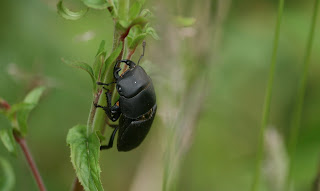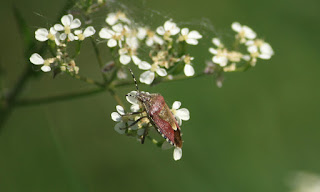20th June 2020
I parked up on the bend in the road up to Curbar Edge from Curbar, camera-less sadly following its unfortunate inundation in the storm which had caught me at Bradford Dale, and took the low path, through the trees, passing some lovely fresh Small Tortoiseshells, and blooming Foxgloves. The woods were fairly bird-quiet, so I made my way up onto the moor, with the Heather and Meadow Pipits. There were loads of people up here, making their entertainment in the outdoors, though perhaps this is typical. A smart Whinchat, a charming summer visitor, migrant relative of the Stonechat, perched atop a frond of Bracken.
 |
| Photos taken on Curbar Edge in 2018 |
I spent a few moments in solstice meditation at the Stone Circle, ancient marker of this rather magical place high in the Eastern moors, and also took in the vistas across the valley, as the Swifts wheeled above and below me. I strolled downhill into Hay Wood, which was beautiful and alive with birdsong, and charming wrens. I reached the Longshaw Estate, National Trust land. The National Trust in Derbyshire was sadly mired in controversy a few years ago, when a gamekeeper was seen to place a plastic decoy Hen Harrier, a fiercely persecuted, endangered and magnificent raptor, and wait by it with a gun, until walkers sent him packing and the Trust ended his employer's shooting lease. This incident did not happen here, but on land near the Snake Pass, according to Raptor Persecution UK, but unfortunately some of the Longshaw Estate remains under grouse shooting management.
There remains a rich, wild beauty to Longshaw's moorland fringes, its moorland though well walked is home to some remarkable wildlife. A Hobby, a small migrant falcon about the size of a kestrel, but faster and more agile, hunted over a blooming moor, its underside boldly streaked, a black mustache on its white cheeks. The sound of aero engines made me look up, as a Harvard trainer flew loudly overhead in formation with a couple of smaller machines and a Nanchang. Further engine sounds a few moments later caused me to look up again, and a Hurricane, iconic fighter of the Battle of Britain, followed the same path through the sky.
Following my pleasant aviation interlude I continued onto the parkland, where a handsome Cuckoo sat silent, my first sighting of this bird this year. I arrived at the heart of the Trust's visitor operation, a popular temporary cafe in a wooden shed, and enjoyed a local ice cream before continuing my exploration of the parkland, enjoying Nuthatches and Coal Tits busy in the branches. A pond on the estate is a great site to see Mandarin ducks.
I left the Longshaw Estate and all its people behind, and continued onto the high, undulating expanse of White Edge, part of Big Moor. This was quieter, though a family disconcertingly allowed their dog to run off lead. Curlews bubbled their mournful calls, and small bands of deer grazed peaceably below, and Meadow Pipits sang. A beautiful Stonechat put on a distraction display beside the path.
 |
| Stonechat photographed at South Walney in 2015 |
As I returned to the car, I was surprised to find many young people gathered around, dressed for a night out in alternative stylings, perhaps en route to some Solstice gathering. Were I ten years younger I might have attempted to join them. I hope they had a good night.
Birds Seen: Mandarin Duck, Mallard, Tufted Duck, Curlew, Woodpigeon, Cuckoo, Swift, Hobby, Magpie, Carrion Crow, Coal Tit, Great Tit, Skylark, Swallow, Willow Warbler, Blackcap, Wren, Nutchatch, Blackbird, Song Thrush, Robin, Whinchat, Stonechat, Pied Wagtail, Meadow Pipit, Chaffinch, Goldfinch.
Mammals: Grey Squirrel, Brown Hare, Red Deer.
Butterflies: Small Tortoiseshell, Red Admiral, Meadow Brown.
Flashback: Curbar Edge, 30th May 2020
Natty and I took a brief drive, the first one since lockdown for a birdy trip together, to Curbar Edge on he Eastern Moors. The sun was high and bright but a gentle breeze cooled the tops. There were many families out enjoying the sun, but possible disturbing the birds somewhat. Meadow Pipits were plentiful and some stonechats a welcome sight, and there was a beautiful red Cardinal Beetle on the heather.
 |
| Cardinal Beetle on Curbar Edge. |
Unfortunately we were witness to an unfolding disaster, as a thick column of smoke rose from the moors somewhere to the North of us. A call to the Eastern Moors RSPB warden to alert him, we found his number online thanks to the miracle of mobile technology, confirmed it was on Bamford Moor, near the Derwent reservoirs. Six fire engines, and a helicopter, I learned on the internet, were needed to put it out, with the support of gamekeepers and other land workers. In these dry summers, keep your barbecues off the moors, people, and don't smoke up there. A fire at this time of year is devastating for bird life, grouse, raptors and stonechats alike nest in the heather, and the frequency of fires in recent summers far exceeds natural levels.
 |
| The Bamford Moor Fire from Curbar Edge. |
We strolled sadly back down the low path, through the leafy birch woodland, where Natty's expert ears picked out Yellowhammer and Cuckoo calling.
Birds Seen: Mallard (flew over) Cuckoo (Heard only) Jackdaw, Carrion Crow, Skylark, Willow Warbler, Chiffchaff, Song Thrush (heard only) Robin, Stonechat, Pied Wagtail, Meadow Pipit, Chaffinch, Goldfinch, Yellowhammer (heard only)
Not Birds Seen: Cardinal Beetle, Small Tortoiseshell, Small Heath, Green Veined White.















































